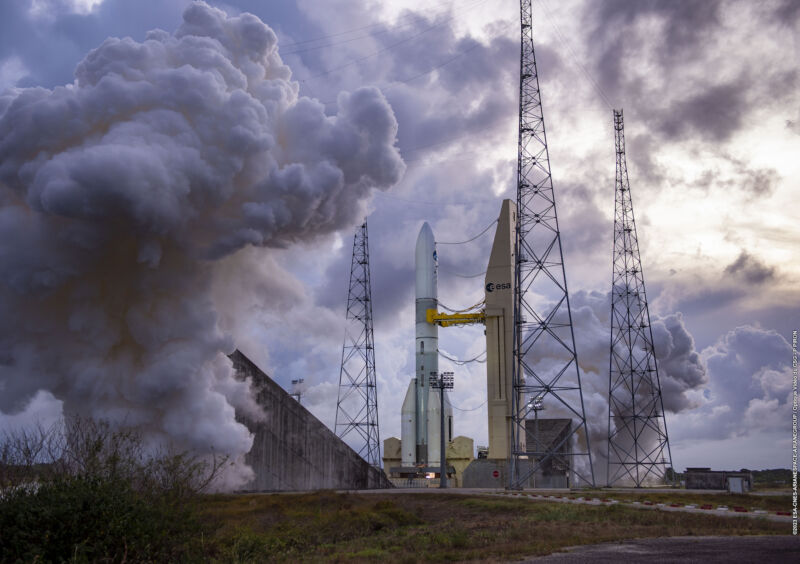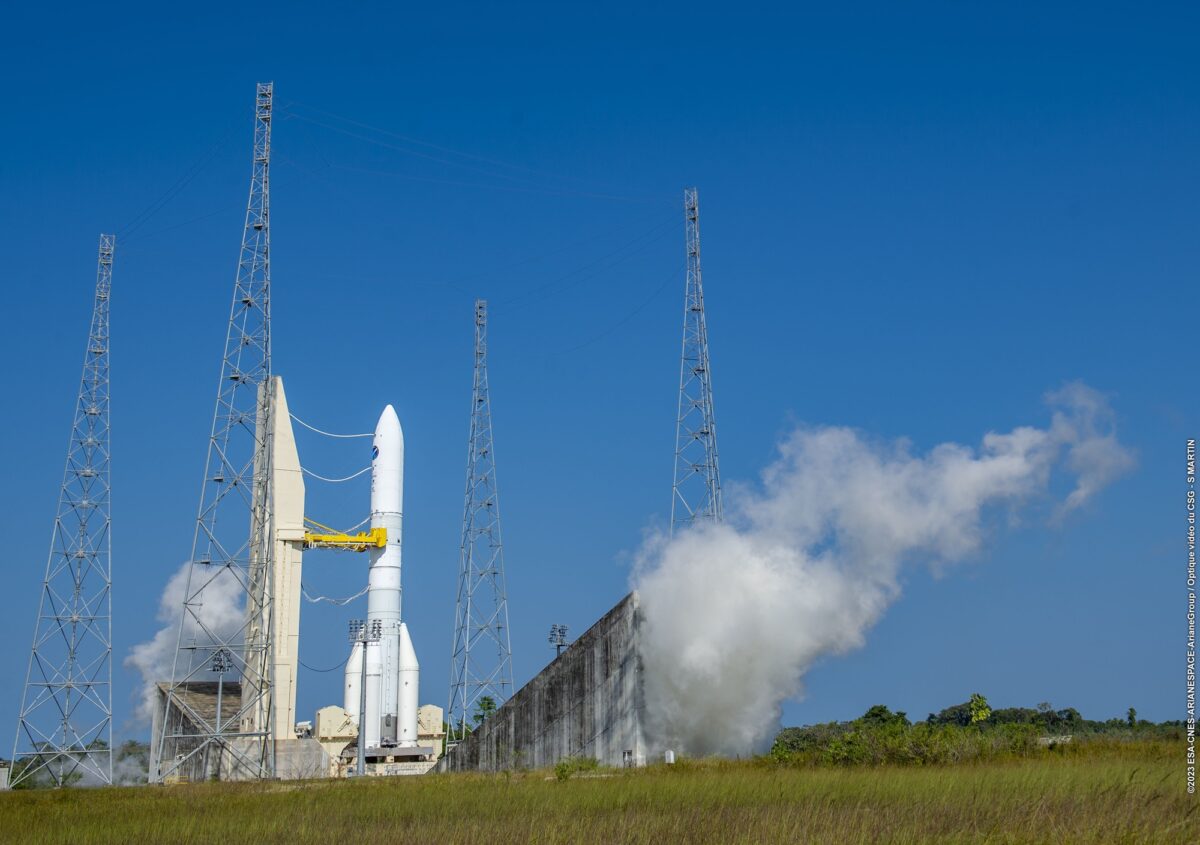
The European Space Agency (ESA) declared success after an Ariane 6 rocket fired its core-stage engine in French Guiana for seven minutes on Thursday, clearing one of a handful of remaining hurdles before the new launcher can lift off on its first test flight.
The Ariane 6's inaugural launch, now scheduled for next year, has been delayed repeatedly since ESA approved the new rocket for development in 2014. The test-firing of the Ariane 6 main engine on a launch pad at the Guiana Space Center in South America last week was the most significant test not yet accomplished on the rocket's preflight checklist.
The test lasted 426 seconds—a little more than seven minutes—while a full-size test model of the Ariane 6 rocket remained on its launch pad. In order for the rocket to actually take off, it would need to light its four strap-on solid-fueled boosters. That was not part of the plan for Thursday's test.
After loading super-cold liquid hydrogen and liquid oxygen propellants into the Ariane 6 rocket, the launch team in French Guiana gave a "go" for ignition of the rocket's Vulcain 2.1 main engine. The engine lit at 3:44 pm EST (20:44 UTC) and throttled up to full power, producing more than 200,000 pounds of thrust.
Thursday's test was nearly a minute shy of the 470-second duration that ESA publicized ahead of time, but officials were satisfied with the result. Several times during the test, the nozzle of the Vulcain 2.1 engine swiveled to exercise the rocket's thrust vector control steering system.
“Ariane 6 now has a core stage and an upper stage which have undergone all testing necessary to be ready for the inaugural flight," said Martin Sion, CEO of ArianeGroup, the joint venture between Airbus and Safran that is responsible for developing the Ariane 6 rocket.
Josef Aschbacher, ESA's director general, said in a statement that engineers "have now run through every step of the rocket's flight without it leaving Earth... We are back on track towards re-securing Europe’s autonomous access to space."
A long road to get here
The Ariane 6 rocket was originally supposed to launch for the first time in 2020, but it's now running four years late. The rocket it will replace, the Ariane 5, made its final flight in July, leaving Europe without a rocket to launch its own space missions. That has prompted ESA and the European Union to look abroad to get spacecraft into orbit. SpaceX, a rival of the European launch service provider Arianespace, has won contracts to launch several ESA missions due to the Ariane 6 delays.
Engineers designed the Ariane 6 as an expendable rocket, with no near-term roadmap to introduce reusable technology into the vehicle. And officials from ESA, which funded the lion's share of the rocket's development, have acknowledged the Ariane 6 will cost more per launch than originally expected.
So there are concerns about the Ariane 6's competitiveness with SpaceX on the commercial launch market. Earlier this month, ESA's member states agreed to change the way the agency develops new rockets. Rather than continuing to follow the top-down, government-managed approach ESA has used to develop European rockets over the last five decades, the agency plans to shift to a more commercial model to make European companies developing new rockets eligible to compete for ESA launch contracts.
In advance of the long-duration engine test last week, the Ariane 6 launch team in French Guiana completed a four-second test firing of the Ariane 6 main engine in September. Last month, teams completed a complex 36-hour countdown rehearsal test that involved the loading and unloading of cryogenic propellants from the rocket's tanks.
Engineers finished qualification testing of the Ariane 6's Vinci upper-stage engine earlier this year on a test stand in Germany. One more test of the Vinci engine is planned for December at the German facility, which will involve checks of the engine's response to simulated in-flight anomalies. That test doesn't need to be completed before the Ariane 6's first test flight, officials said.
The hydrogen-fueled Vinci engine on the Ariane 6's upper stage is one of the rocket's major new elements. It is designed to restart in space, replacing the Ariane 5's upper-stage engine that was only capable of a single burn on each mission.
In the coming weeks, ground crews in French Guiana will lower the Ariane 6 rocket used during this year's tests off its launch pad and roll it back to a nearby hangar. The core stage and upper stage assigned to the first Ariane 6 launch will ship to French Guiana from factories in France and Germany for final flight preparations.
"On this final stretch towards the first flight, we still have to carry out a few additional tests to demonstrate fault tolerance, deliver the first launcher to Kourou, and perform the launch system qualification review,” Sion said.
Later this week, officials from ESA and ArianeGroup plan to brief the media on the full results from the Ariane 6 test campaign and announce a schedule for the rocket's first flight.



3175x175(CURRENT).thumb.jpg.b05acc060982b36f5891ba728e6d953c.jpg)
Recommended Comments
There are no comments to display.
Join the conversation
You can post now and register later. If you have an account, sign in now to post with your account.
Note: Your post will require moderator approval before it will be visible.